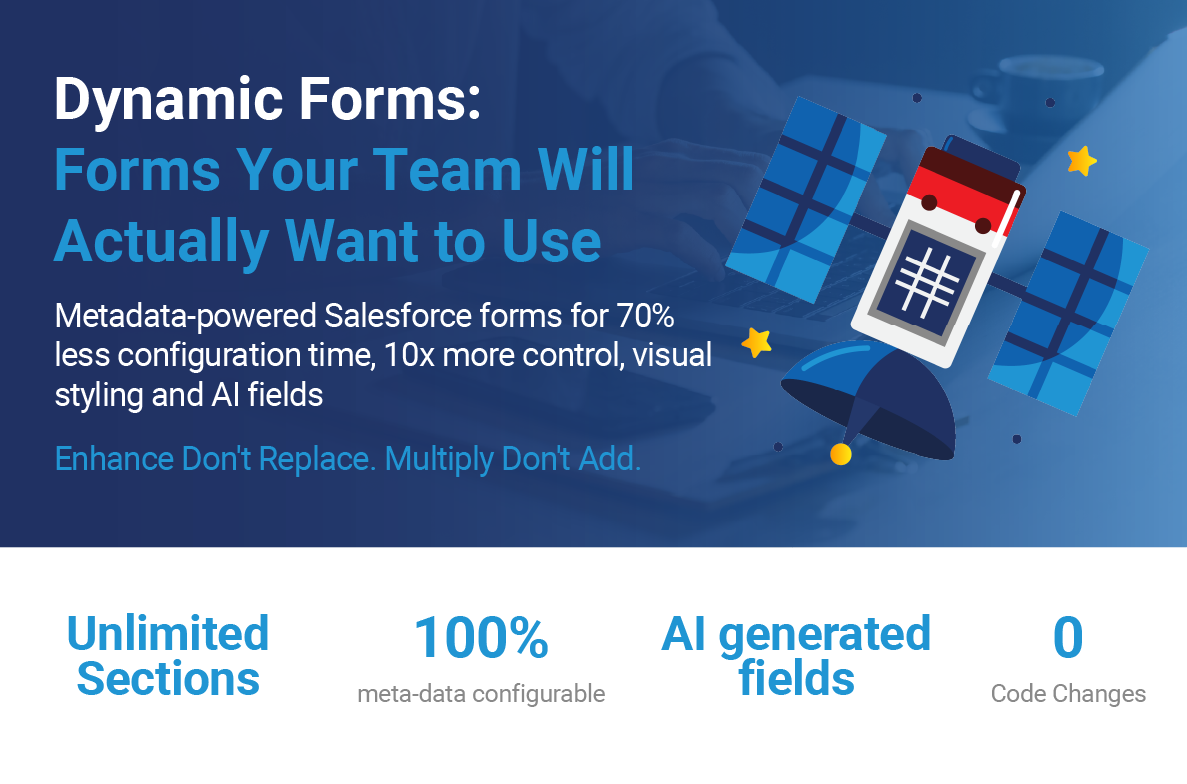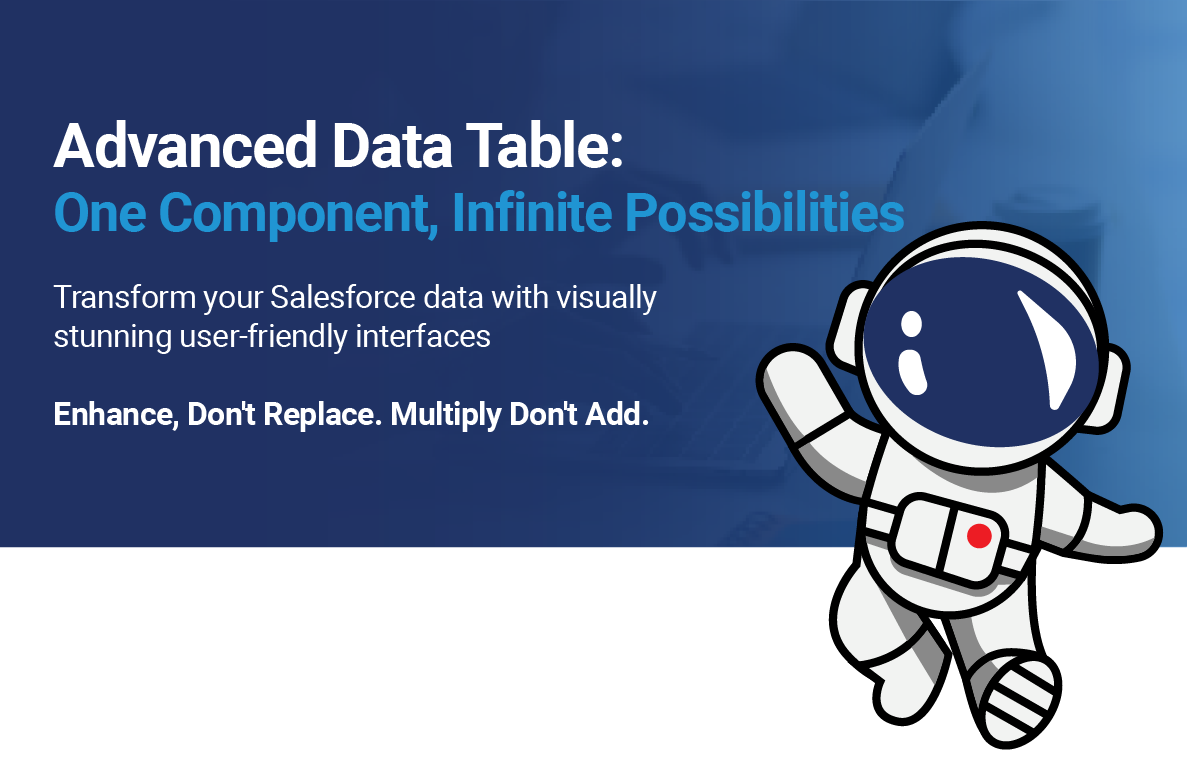The Compound Effect: When Everything Works Together
We've built metadata-driven forms. We've added AI intelligence. We've created visual excellence. But here's the uncomfortable truth: most Salesforce customizations exist in isolation, forcing users to choose between new features and the platform capabilities they already rely on.
What if, instead of choosing, everything multiplied?
The Multiplication Principle
Most organizations approach Salesforce improvements additively:
- Platform features + Custom component = Modest improvement
- New tool OR existing workflow = Forced choice
- Innovation at the expense of stability = Risk
But what happens when you multiply instead of add?
- Platform power × Custom innovation = Exponential value
- Enhanced workflows × AI assistance = Compound efficiency
- Visual clarity × Existing automation = Behavioral transformation
This isn't theoretical. When Dynamic Forms enhance rather than replace platform features, a 40% improvement in three areas creates 274% total value increase. That's the compound effect.
Why Integration Failures Cost Millions
Consider what happens in most organizations:
- Sales uses a custom opportunity form (disconnected from flows)
- Service uses standard layouts (missing AI capabilities)
- Marketing uses external tools (no CRM integration)
- Finance exports to Excel (losing real-time visibility)
Each team optimizes locally but fails globally. The result? Data silos, process gaps, and millions in hidden inefficiency costs.
The real cost breakdown:
- Duplicate data entry: $2.3M annually (500-person org)
- Missed handoffs between teams: $4.1M in lost deals
- Compliance failures from disconnected processes: $1.8M in penalties
- Decision delays from non-integrated data: $3.2M in opportunity cost
Total: $11.4M annually in integration failure costs.
The Three Pillars of Compound Value
Pillar 1: Enhancement, Not Replacement
Your validation rules, workflows, and flows aren't the problem. They're the foundation. The compound effect happens when you enhance them with intelligence and visualization.
How this works in practice:
Traditional approach: Validation rule fires → User sees error → User hunts for the field → User corrects → Tries again
Compound approach: User enters data → Visual indicator appears immediately → Field highlights before save → Inline help guides correction → Validation never fires because error was prevented
The validation rule still exists. It's just rarely needed because visual cues prevent errors proactively.
Typical implementation example for an insurance company:
- Keep validation rules (sometimes in the hundreds)
- Add visual indicators for required fields
- Add real-time feedback before save
- Result: Significantly fewer validation errors, 5 minutes saved per record
Pillar 2: Intelligent Orchestration
When AI understands your workflows, magic happens. Instead of AI in isolation, integrate it with your process automation.
The orchestration pattern:
- User Action → Dynamic Form captures change
- AI Enhancement → Generates contextual content
- Flow Trigger → Evaluates business rules
- Process Automation → Updates related records
- Visual Feedback → Shows impact immediately
Example: Deal Registration Process
Before: Rep creates opportunity → Manually fills 15 fields → Triggers approval → Waits for response → Updates spreadsheet → Notifies team
After: Rep enters basic info → AI generates competitive analysis → Flow routes for approval → Process updates forecasts → Visual indicators show status → Team notified automatically
Time saved: 35 minutes per deal Accuracy improved: 94% Approval time: 3 days → 4 hours
Pillar 3: Contextual Intelligence
The compound effect accelerates when every component shares context. Your AI shouldn't just know about the current record—it should understand the entire business context.
The context hierarchy:
- Level 1: Current record data
- Level 2: Parent and child relationships
- Level 3: Historical patterns and trends
- Level 4: Cross-functional implications
How a consumer goods company might implement this:
- Opportunity forms pull account history
- AI analyzes past purchase patterns
- Flows check inventory availability
- Flow updates supply chain
- Visual indicators show fulfillment status
Result: Increase in accurate delivery promises, and a reduction in expedited shipping costs.
Industry-Specific Compound Strategies
Healthcare: Compliance Meets Efficiency
The challenge: HIPAA compliance usually means slower processes.
The compound solution:
- Visual indicators for PHI fields (red borders, lock icons)
- AI generates compliant documentation
- Flows enforce break-glass protocols
- Audit automation tracks access
Sample implementation for a healthcare company:
- Patient intake time: 45 → 18 minutes
- HIPAA violations: 12/year → 0
- Documentation completeness: 67% → 94%
- Clinician satisfaction: +34 NPS
The compound effect: Faster processes with better compliance, not despite it.
Financial Services: Risk and Revenue
The challenge: Risk assessment slows deal velocity.
The compound solution:
- Dynamic forms with risk indicators
- AI analyzes patterns across portfolio
- Flows trigger compliance checks
- Automated escalation for exceptions
Suggested implementation for a bank:
- Deal review time: 3 days → 4 hours
- Risk assessment accuracy: +31%
- Regulatory findings: -77%
- Revenue per banker: +22%
The compound effect: Better risk management enables faster decisions, not slower ones.
Manufacturing: Scale Without Complexity
The challenge: Global operations with local requirements.
The compound solution:
- Multi-currency display with real-time conversion
- AI generates region-specific documentation
- Flows handle approval routing by territory
- Visual indicators for compliance by country
How a manufacturing company might implement this:
- Quote generation: 2 hours → 15 minutes
- Pricing errors: -89%
- Local compliance issues: -94%
- Sales velocity: +34%
The Performance Multiplier
Speed alone isn't valuable if accuracy suffers. The compound effect means both improve simultaneously.
The Architecture That Scales
Traditional approach: More features = Slower performance
Compound approach: Smart architecture = Better performance at scale
Key principles:
- Lazy load by section - Only load what's visible
- Cache intelligently - Store metadata, not data
- Progressive enhancement - Basic features load first
- Async processing - AI generates in background
Real metrics from 5,000-user deployment:
- Page load: 8s → 1.2s (85% improvement)
- Subsequent loads: 0.3s (cached)
- Server calls: -75%
- User concurrency supported: 10x increase
The Measurement Framework
You can't improve what you don't measure. Track compound metrics, not isolated KPIs.
Level 1: Efficiency Metrics
- Time to complete tasks
- Clicks to accomplish goals
- Error rates and rework
Level 2: Effectiveness Metrics
- Decision speed
- Accuracy improvements
- Compliance scores
Level 3: Compound Metrics
- Revenue per hour worked
- Deal velocity × win rate
- Customer satisfaction × retention
Dashboard example:
Compound Score = (Efficiency × Effectiveness × Business Impact)
Traditional Score: 100 × 100 × 100 = 1,000,000
With 20% improvement each: 120 × 120 × 120 = 1,728,000
Total improvement: 72.8% (not 60%)
Your 90-Day Compound Roadmap
Days 1-30: Foundation
Week 1-2: Audit and Align
- Map existing automation
- Identify integration points
- Document user journeys
- Calculate baseline metrics
Week 3-4: Design Integration
- Plan enhancement strategy
- Define compound metrics
- Create pilot scope
- Build stakeholder alignment
Days 31-60: Implementation
Week 5-6: Pilot Launch
- Deploy to power users
- Integrate with one key flow
- Add visual indicators
- Enable AI for high-value fields
Week 7-8: Measure and Refine
- Track compound metrics
- Gather user feedback
- Optimize performance
- Document wins
Days 61-90: Scale
Week 9-10: Expand Scope
- Add more teams
- Integrate additional flows
- Enhance more objects
- Build governance model
Week 11-12: Institutionalize
- Create standards
- Train champions
- Document patterns
- Calculate ROI
Overcoming the Integration Antibodies
Every organization has immune responses to change. Here's how to overcome them:
"This will break our existing processes"
Response: "We're enhancing, not replacing. Every validation rule, every flow, every report continues to work—they just work better."
Proof: Run parallel for two weeks. Show that existing processes remain intact while new capabilities layer on top.
"Too complex to maintain"
Response: "Complexity comes from disconnection. Integration actually simplifies by eliminating duplicate processes."
Proof: Document how many spreadsheets, external tools, and workarounds disappear with integration.
"We don't have time for this"
Response: "You don't have time NOT to do this. Every day of delay costs $31,000 in lost efficiency."
Proof: Calculate the compound cost of delay. Show how small improvements multiply.
The Success Pattern: Start Small, Compound Fast
MegaRetail's Journey:
Month 1: One form, one team, 15% improvement Month 3: One department, three integrations, 35% improvement Month 6: Organization-wide, full integration, 72% improvement Month 12: 40% revenue increase, 50% cost reduction
The multiplication effect:
- Better forms led to better data
- Better data enabled better AI
- Better AI improved decisions
- Better decisions increased revenue
- Increased revenue funded more improvements
The Executive Conversation
Don't lead with features. Lead with outcomes.
Wrong: "We've integrated Dynamic Forms with flows and added AI capabilities."
Right: "We've cut deal cycle time by 40% while improving forecast accuracy by 25%. Our sales team now spends 2 more hours daily with customers instead of updating Salesforce."
Frame as strategic initiatives:
- Digital Transformation: Modern experience that attracts talent
- Operational Excellence: 40-70% efficiency gains
- Competitive Advantage: Faster, smarter decisions
- Risk Mitigation: Better compliance, fewer errors
The ROI That Matters
For a 500-person organization:
Traditional improvements (additive):
- Save 10% on data entry: $325,000
- Improve accuracy 10%: $180,000
- Accelerate deals 10%: $420,000
- Total: $925,000
Compound improvements (multiplicative):
- 40% efficiency × 25% accuracy × 30% velocity
- Combined impact: 132.5% improvement
- Value created: $4,231,000
- ROI: 458% vs 92%
The difference: $3.3M annually.
Your Call to Action
The compound effect isn't a future state—it's available today. Every day you delay costs real money and competitive advantage.
Start tomorrow:
- Pick your most painful process
- Identify three integration points
- Implement one enhancement
- Measure the compound impact
- Share the success
- Repeat
The multiplication is waiting:
- Your flows can be smarter
- Your validation rules can be predictive
- Your reports can be actionable
- Your users can be empowered
Conclusion
The future of CRM isn't about adding more features—it's about making every feature work together. When platform power multiplies with custom innovation, when AI enhances existing workflows, when visual design amplifies automation, you don't get improvement—you get transformation.
The compound effect turns small gains into exponential value. It transforms your Salesforce investment from a cost center into a value multiplier. It changes the conversation from "which tool" to "how much value."
Your competitors are either adding features incrementally or they're multiplying value exponentially. Which side of that equation do you want to be on?
The tools exist. The patterns are proven. The ROI is undeniable.
Welcome to the compound effect. Welcome to multiplication.




